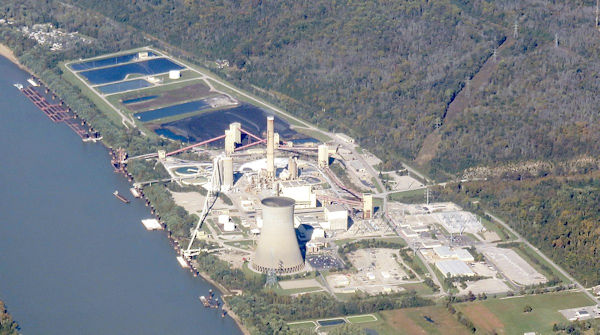SEJournal Online is the digital news magazine of the Society of Environmental Journalists. Learn more about SEJournal Online, including submission, subscription and advertising information.
 |
| Above, an aerial image of the recently closed William H. Zimmer Power station on the Ohio River, showing coal ash disposal sites at rear. The EPA is scrutinizing closure plans for more than 160 other coal ash facilities. Photo: Antony-22, Wikimedia Commons (CC BY-SA 4.0). |
TipSheet: EPA Leak on Problem Coal Ash Sites Could Yield Local Drinking Water Stories
By Joseph A. Davis
There is nothing like a leaked list to send reporters scurrying. And when it’s a list of problematic coal ash storage ponds, environmental journalists can use it as a list of leads for local stories.
The original scoop came from water policy reporter Hannah Northey of E&E News, whose June 14 story featured a leaked list of more than 160 coal ash facilities in 26 states whose closure plans are being investigated by the U.S. Environmental Protection Agency.
Why it matters
For many years, coal was the largest source of electric power in the United States. Many of those old plants have closed today, but not all have fixed the big leftover pollution problem that comes from coal ash.
That coal ash, as we’ve noted in an earlier TipSheet, has historically been stored in ponds or pits that were unlined and poorly contained. Some of those pits and ponds are unstable or may flood or spill — but the biggest threat is that they can pollute aquifers people use for drinking water.
It’s actually more than just ash — the industry’s waste product includes pollutants removed from the stack. Among them are lead, mercury, cadmium, chromium, arsenic and selenium, in amounts that could harm human health.
The backstory
The EPA didn’t spend much energy regulating coal ash until a massive December 2008 spill at the Tennessee Valley Authority’s Kingston Fossil Plant in Tennessee. President Obama, who was just taking office, vowed to address the problem.
The Obama EPA had only managed to
issue a deeply compromised rule that
left a lot of leeway to the states, which
wanted to cut the utilities plenty of slack.
By the end of his administration in 2015, the Obama EPA had only managed to issue a deeply compromised rule that left a lot of leeway to the states, which wanted to cut the utilities plenty of slack.
As bad as that rule was, the Trump EPA made a point of rolling it back and weakening it twice. Upon taking over, President Biden’s EPA officials declared their intention to enforce coal ash rules more stringently when states did not do so.
The newly leaked list is an indicator of the Biden crackdown. The EPA is insisting that coal ash dumps cannot close if the ash is still in contact with groundwater. The list of 160 includes dumps where the EPA believes that to be the case and wants more information about closure plans.
Story ideas
- Is there a coal ash storage or disposal site near you? There probably is one at your nearest coal-burning power plant. Check the bigger lists.
- Is your coal ash pond lined with an impermeable layer (e.g., clay) to isolate it from groundwater? Probably not.
- Is there a closure plan for either the power plant or the coal ash pond? Get a copy and talk it over with groundwater experts.
- If there is not a closure plan, what is the utility doing to develop one? Will there be public disclosure and comment? Where will the waste find a permanent home?
- What is the state’s position on the closure plan? What is the EPA’s? What do local environmental groups say?
- Who will pay for the closure and safe, permanent disposal of the coal ash in question? The utility? Ratepayers? Someone else?
- Does the closure plan include monitoring of groundwater? Who will do this and who will ensure that it gets done?
- What ground or surface water could be polluted by the coal ash? What is being done to address the problem?
Reporting resources
- The leaked list: Start there, as the list probably includes the sites most deserving of attention.
- The EPA: The agency has a lot of information about the threats presented by coal ash to air and water quality. Get more on coal ash basics, steps to protect groundwater, coal combustion residuals and their disposal.
- Compliance data: A list of publicly accessible internet sites hosting compliance data and information required by the disposal of coal combustion residuals rule.
- Earthjustice map: An even fuller list than the leaked one, presented in map format, from the public interest environmental law organization. Its list contains 738 coal ash units in 43 states and Puerto Rico. Earthjustice maintains that almost all of them are contaminating groundwater with pollutants above EPA drinking water standards.
[Editor’s Note: For more on the coal ash story, read this TipSheet on using coal ash data to help pinpoint local pollution stories and for the latest coal ash-related headlines, see top stories from EJToday.]
Joseph A. Davis is a freelance writer/editor in Washington, D.C. who has been writing about the environment since 1976. He writes SEJournal Online's TipSheet, Reporter's Toolbox and Issue Backgrounder, and curates SEJ's weekday news headlines service EJToday and @EJTodayNews. Davis also directs SEJ's Freedom of Information Project and writes the WatchDog opinion column.
* From the weekly news magazine SEJournal Online, Vol. 7, No. 25. Content from each new issue of SEJournal Online is available to the public via the SEJournal Online main page. Subscribe to the e-newsletter here. And see past issues of the SEJournal archived here.













 Advertisement
Advertisement 



